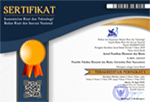ANALISIS KINERJA EKONOMI SEBELUM DAN PADA ERA PENETAPAN KEISTIMEWAAN YOGYAKARTA
DOI:
https://doi.org/10.33633/jpeb.v4i2.2342Abstract
ABSTRACTThis study aims to determine the level of success of economic performance before and in the era of Yogyakarta privileges determination. This study uses several relevant analytical methods to analyze economic performance. The economic performance will be observed through economic indicators and development indicators in support of the principle of the Specialties of Daerah Istimewa Yogyakarta (DIY). The methods applied in this research are description of indicators to provide a description of the performance of all activities carried out before and on the appointment of privilege, paired sample t-test to analyze situations that existed before and when implemented a police and Data Panel Regression Analysis. It was concluded that the adjustment funds before the dana istimewa (danais) had given good growth to DIY. DIY growth was seen after the danais program in 2013-2015 which increased by 0.98%. This finding is in accordance with the expectations of researchers. Danais in the 2015 APBNP was recorded at 0.547 TrillionKeywords: Economic Performance, Inequality and Growth  ABSTRAKPenelitian ini bertujuan untuk mengetahui tingkat keberhasilan kinerja ekonomi sebelum dan pada era penetapan keistimewaan Yogyakarta. Penelitian ini menggunakan beberapa metode analisis yang relevan untuk menganalisis kinerja ekonomi. Kinerja ekonomi akan diamati melalui indikator ekonomi dan indikator pembangunan untuk mendukung prinsip Keistimewaan Daerah Istimewa Yogyakarta (DIY). Metode yang digunakan dalam penelitian ini adalah deskripsi indikator untuk memberikan deskripsi kinerja semua kegiatan yang dilakukan sebelum dan pada penetapan keistimewaan, paired sample t-test untuk menganalisis situasi yang ada sebelum dan pada implementasi kebijakan dan Analisis Regresi Panel Data. Disimpulkan bahwa dana penyesuaian sebelum adanya danais telah memberikan pertumbuhan yang baik terhadap DIY. Pertumbuhan DIY terlihat setelah adanya program danais pada tahun 2013-2015 yang meningkat sebesar 0,98%. Temuan ini sesuai dengan harapan peneliti. Danais pada APBNP-2015 tercatat sebesar 0,547 Triliun.Kata Kunci: Kinerja Ekonomi, Ketimpangan, dan PertumbuhanReferences
BPS. (2014). D.I. Yogyakarta Dalam Angka 2014 / D.I. Yogyakarta in Figures 2014, 1–640.
Budiharsono, S. (1989). Perencanaan Pembangunan Wilayah (Teori, Model Perencanaan, dan Penerapannya). Bogor: IPB.
Chenery, H., & Syrquin, M. (1975). Pattemn of Development 1950-1970. (Oxford University Press., Ed.), A World Bank research publication. New York. Retrieved from http://documents.worldbank.org/curated/en/482491468328816108/Patterns-of-development-1950-1970
Clark, C. O. (1949). Application of Flood-Storage Accounting Methods. Transactions, American Geophysical Union, 30(4), 528–532. https://doi.org/10.1360/zd-2013-43-6-1064
Coudouel, A., Hentschel, J., & Wodon, Q. (2001). Well-Being Measurement and Analysis.
Fisher, R. . (1935). The Fiducial Argument in Statistical. Annals of Human Genetics, 6(4), 391–398.
Hirschman, A. (1958). The Strategy of Economic Development. (Y. U. Press, Ed.). New Haven.
Jaweng, R. E. (2013). Keistimewaan Yogyakarta: Babak Baru yang Menyisakan Sejumlah Catatan. Jurnal Ilmu Pemerintahan Indonesia, 42, 105–119.
Kuncoro, M. (2006). Ekonomi Pembangunan. Jakarta: Salemba Empat.
Kuznets, S. (1973). Modern Economic Growth. THe American Econonic Review, 63(3), 247–258. https://doi.org/10.2307/1910352
Lewis, W. A. (1954). Economic Development with Unlimited Supplies of Labour. The Manchester School, 22(2), 139–191. https://doi.org/10.1111/j.1467-9957.1954.tb00021.x
Meier, G. M. (1995). Leading Issues in Economic Development (6th edition). Oxford: Oxford University Press.
Myrdal, G. (1957). Economic Theory and Under-Developed Regions. London: G. Duckworth.
Richardson. (1978). Regional & Urban Economics. Penguin Books.
Susanti et. al, H. (1995). Indikator-Indikator Makroekonomi. Jakarta: Lembaga Penerbit FEUI.
Syaukani. (2005). Peningkatan Kinerja Eksekutif dan Implementasi Otonomi Daerah, dalam Haris, Syamsuddin (2005). Desentralisasi dan Otonomi Daerah. Jakarta: LIPI Press.
Widodo, T. (2006). Perencanaan Pembangunan: Aplikasi Komputer Era Otonomi Daerah. Yogyakarta: UPP STIM YKPN.
Yasa, I. K. O. A., & Arka, S. (2015). Pengaruh Pertumbuhan Ekonomi Dan Disparitas Pendapatan Antardaerah Terhadap Kesejahteraan Masyarakat Provinsi Bali. E-Jurnal Ekonomi Pembangunan Universitas Udaya, 4(2), 129–137.
Yeniwati. (2013). PENDAHULUAN Ketimpangan , pemerataan , dan infrastruktur sebenarnya telah dikenal cukup lama di Indonesia , misalnya melatar belakangi program padat karya berbagai pembangunan infrastruktur , berbagai program jaring pengaman sosial ; pembangunan jaringan, II(3), 1–21.
Ying, L. G. (1999). China’s Changing Regional Disparities during the Reform Period. Economic Geography, 75(1), 59–70.
Downloads
Published
How to Cite
Issue
Section
License
The copyright of the received article shall be assigned to the journal as the publisher of the journal. The intended copyright includes the right to publish the article in various forms (including reprints). The journal maintains the publishing rights to the published articles.
This work is licensed under a Creative Commons Attribution 4.0 International License.



.png)









